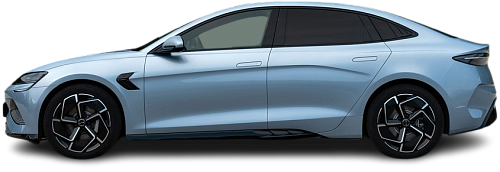Global EV Comparison: BMW i4 eDrive40 vs BYD Seal Design RWD
Struggling to Decide? Let AI Help!
Your AI Summary Is Ready!
General Info
Both vehicles are currently in production and can be purchased new. The BMW i4 eDrive40 (2025-...) has a starting price of €60600, compared to the BYD Seal Design RWD (2022-…), which starts at €44990.
The BMW i4 eDrive40 (2025-...) is a Liftback, whereas the BYD Seal Design RWD (2022-…) is a Sedan.
| Property | BMW i4 eDrive40 | BYD Seal Design RWD |
|---|---|---|
| Years of Production | 2025-… | 2022-… |
| Current Status | Produced | Produced |
| Country of Manufacture | Germany | China |
| Body Style | Liftback | Sedan |
| Market Availability | EU, USA | EU |
| Price Europe (New) | €60600 | €44990 |
| Price Europe (Used) | - Price Europe (Used) | €38440 |
| GCC Score | 6.5 | 6.5 |
Range and Efficiency
Even though the BYD Seal Design RWD (2022-…) has a larger battery, the BMW i4 eDrive40 (2025-...) higher energy efficiency results in a longer real-world driving range.
| Property | BMW i4 eDrive40 | BYD Seal Design RWD |
|---|---|---|
| Range (WLTP) | 613 km | 570 km |
| Range (GCC) | 490 km | 485 km |
| Battery Capacity (Nominal) | 83.9 kWh | 84 kWh |
| Battery Capacity (Usable) | 81.3 kWh | 82.5 kWh |
| Efficiency per 100 km | 16.6 kWh/100 km | 17 kWh/100 km |
| Efficiency per kWh | 6.03 km/kWh | 5.88 km/kWh |
| Range and Efficiency Score | 8.4 | 8.2 |
Charging
Both vehicles utilize a standard 400-volt architecture.
The BMW i4 eDrive40 (2025-...) offers faster charging speeds at DC stations, reaching up to 205 kW, while the BYD Seal Design RWD (2022-…) maxes out at 150 kW.
Both vehicles are equipped with the same on-board charger, supporting a maximum AC charging power of 11 kW.
| Property | BMW i4 eDrive40 | BYD Seal Design RWD |
|---|---|---|
| Max Charging Power (AC) | 11 kW | 11 kW |
| Max Charging Power (DC) | 205 kW | 150 kW |
| Architecture | 400 V | 400 V |
| Charge Port | CCS Type 2 | CCS Type 2 |
| Charging Score | 6.9 | 6.5 |
Performance
Both vehicles are rear-wheel drive.
The BMW i4 eDrive40 (2025-...) boasts greater motor power and accelerates faster from 0 to 100 km/h.
| Property | BMW i4 eDrive40 | BYD Seal Design RWD |
|---|---|---|
| Drive Type | RWD | RWD |
| Motor Type | PMSM | PMSM |
| Motor Power (kW) | 250 kW | 230 kW |
| Motor Power (hp) | 335 hp | 308 hp |
| Motor Torque | 430 Nm | 360 Nm |
| 0-100 km/h | 5.6 s | 5.9 s |
| Top Speed | 190 km/h | 180 km/h |
| Performance Score | 4.9 | 4.5 |
Dimensions
The BMW i4 eDrive40 (2025-...) and BYD Seal Design RWD (2022-…) are about the same size.
The BYD Seal Design RWD (2022-…) boasts a more extended wheelbase.
| Property | BMW i4 eDrive40 | BYD Seal Design RWD |
|---|---|---|
| Length | 4783 mm | 4800 mm |
| Width (with Mirrors) | 2073 mm | 2150 mm |
| Width (w/o Mirrors) | 1852 mm | 1875 mm |
| Height | 1448 mm | 1460 mm |
| Wheelbase | 2856 mm | 2920 mm |
Cargo and Towing
A frunk (front trunk) is available in the BYD Seal Design RWD (2022-…), but the BMW i4 eDrive40 (2025-...) doesn’t have one.
The BMW i4 eDrive40 (2025-...) is better suited for heavy loads, offering a greater towing capacity than the BYD Seal Design RWD (2022-…).
| Property | BMW i4 eDrive40 | BYD Seal Design RWD |
|---|---|---|
| Number of Seats | 5 | 5 |
| Curb Weight | 2120 kg | 2055 kg |
| Cargo Volume (Trunk) | 470 l | 400 l |
| Cargo Volume (Max) | 1290 l | - Cargo Volume (Max) |
| Cargo Volume (Frunk) | - Cargo Volume (Frunk) | 53 l |
| Towing Capacity | 1600 kg | 750 kg |
| Cargo and Towing Score | 5 | 5.3 |




